

IPIP Home. 3 ‘Knowns’ in Learning Science—and How to Apply Them in Practice. The key to unlocking a brighter future for students lies within the understanding and application of learning science.
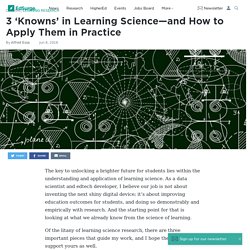
As a data scientist and edtech developer, I believe our job is not about inventing the next shiny digital device; it’s about improving education outcomes for students, and doing so demonstrably and empirically with research. And the starting point for that is looking at what we already know from the science of learning. Of the litany of learning science research, there are three important pieces that guide my work, and I hope they will help support yours as well. Bloom’s Two Sigma Problem Benjamin Bloom, one of America’s leading educational psychologists, is most famous for “Bloom’s Taxonomy,” but in 1984 he wrote a seminal paper in learning science called the “Two Sigma Problem.”
A Grading Strategy That Puts the Focus on Learning From Mistakes. "I see that now when I give tests back, they're continuing to learn," Alcala said. The students get their grade a day later on PowerSchool, and they're given opportunities to retake the test after they've digested their mistakes. Alcala also projects "favorite mistakes" on the board that they talk about as a class. And students get time to look at their own mistakes and figure out where they went wrong. The other advantage of highlighting is that she can call attention to things that she won't necessarily take points off for, but that she wants students to notice.
For example, she might highlight that they didn't put the correct units in a word problem. She grades in two go-rounds. After the first pass of the test, Alcala looks at the test as a whole for themes in the kinds of mistakes the child is making. "ابحث عن شغفك".. لماذا تعد أسوأ نصيحة على الإطلاق؟ "إذا كان الشغف هو شيء كامل وجاهز، وكل وظيفتك هي أن تجوب العالم بحثا عنه، فتلك هي فكرة مجنونة" (جورج والتون) إذا حدث ووقفت في أحد المدرجات بالجامعة ثم سألت بصوت عالٍ: "من منكم يبحث عن شغفه؟"، فغالبا ما ستكون إجابة الغالبية من الجالسين بالإيجاب، ومن منّا لا يبحث عنه؟ من الذي لا يريد أن يجد تلك الموهبة المدفونة في جوانب شخصيته كي يخرج بها للنور ويعمل -أخيرا- في وظيفة الأحلام، لطالما سحرت أفلام كـ "بيوتيفل مايند" (Beautiful mind) خيالنا، علمتنا أن الشغف هو حجر الأساس في الإنجاز، وأن الموهبة هي سر الإبداع، فلا يمكن لنا أن نمارس عملا نحبه إلا ونحن غارقون في النشوة أثناء أدائه، تلك النشوة التي تلهينا عن كل شيء في الخارج، أليس كذلك؟ يدفعنا ذلك لتأمل الدور الذي يمكن أن تلعبه أفكارنا عن الذكاء والشغف في حياتنا، تلك الأفكار التي تقع بشكل ضمني في خلفية سلوكنا.

في خمس دراسات(5) متتالية وجد الفريق البحثي أن هؤلاء ذوي المنظومات العقلية الثابتة واجهوا مشكلات في استكشاف النطاقات المعرفية المختلفة عن اهتماماتهم. هل مفاهيم علم النفس الغربية تنطبق علينا نحن في الشرق؟ تطوّر التخصص الأكاديمي لعلم النفس بصورة عامة في أميركا الشمالية وأوروبا.

قد يقول البعض بأنه نجح بشكل ملحوظ في فهم دوافع السلوك البشري والعمليات العقلية، والتي لطالما كان يُعتقد أنها متماثلة في جميع البشر. لكن في العقود الأخيرة، بدأ بعض الباحثين في التشكيك في هذا النهج، بحجة أن العديد من الظواهر النفسية تتشكّل من الثقافة التي نعيش فيها. من الواضح أن البشر متشابهون في كثير من النواحي، فنحن نتشارك الفسيولوجيا نفسها ولدينا الاحتياجات الأساسية نفسها، مثل التغذية والسلامة والنشاط الجنسي. إذن، ما التأثير الذي يمكن حقا أن يكون للثقافة على الجوانب الأساسية في نفوسنا، مثل الوعي والإدراك والشخصية؟ دعونا نُلقي نظرة على الأدلة المتوفرة حتى الآن. Growth Mindset Parenting. 6 Purely Psychological Effects of Washing Your Hands. Wash your hands, wash your mind: recover optimism, feel less guilty, less doubtful and more… Washing your hands doesn’t just keep you healthier; it has all sorts of subtle psychological effects as well.

Hand washing sends an unconscious metaphorical message to the mind: we don’t just cleanse ourselves of physical residues, we also cleanse ourselves of mental residues. So, here are six purely psychological effects of washing your hands… Interacting with women can impair men’s cognitive functioning - ScienceDirect. <div pearltreesdevid="PTD138" role="alert" class="alert-message-container"><div pearltreesdevid="PTD139" aria-hidden="true" class="alert-message-body"><span pearltreesdevid="PTD140" style="display: inline-block;" class="Icon IconAlert"><svg pearltreesDevId="PTD141" style="width: 100%; height: 100%;" width="24" height="24" focusable="false" tabindex="-1" fill="currentColor"><path pearltreesDevId="PTD142" fill="#f80" d="M11.84 4.63c-.77.05-1.42.6-1.74 1.27-1.95 3.38-3.9 6.75-5.85 10.13-.48.83-.24 1.99.53 2.56.7.6 1.66.36 2.5.41 3.63 0 7.27.01 10.9-.01 1.13-.07 2.04-1.28 1.76-2.39-.1-.58-.56-1.02-.81-1.55-1.85-3.21-3.69-6.43-5.55-9.64-.42-.52-1.06-.83-1.74-.79z"></path><path pearltreesDevId="PTD143" d="M11 8h2v5h-2zM11 14h2v2h-2z"></path></svg></span><!

-- react-text: 58 -->JavaScript is disabled on your browser. Please enable JavaScript to use all the features on this page. <! -- /react-text --></div></div> Abstract Keywords. Contact with attractive women affects the release of cortisol in men. Stephen's Web ~ Assessing Learning Outcomes: Thinking Critically about Critical Thinking and Written Communication Skills. When I think about my own intellectual history I can think of several keystone events in which I received explicit guidance in critical thinking (and writing) which advanced my thinking significantly.
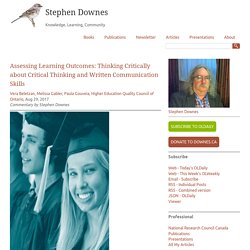
What is Self-Determination Theory? (+PDF) Selfdeterminationtheory.org – Intrinsic Motivation Inventory (IMI) NOTE: Refresh your browser if you are unable to download the scale.
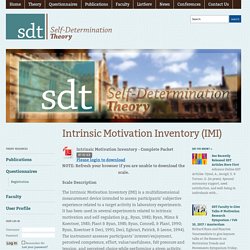
Scale Description The Intrinsic Motivation Inventory (IMI) is a multidimensional measurement device intended to assess participants’ subjective experience related to a target activity in laboratory experiments. It has been used in several experiments related to intrinsic motivation and self-regulation (e.g., Ryan, 1982; Ryan, Mims & Koestner, 1983; Plant & Ryan, 1985; Ryan, Connell, & Plant, 1990; Ryan, Koestner & Deci, 1991; Deci, Eghrari, Patrick, & Leone, 1994). The instrument assesses participants’ interest/enjoyment, perceived competence, effort, value/usefulness, felt pressure and tension, and perceived choice while performing a given activity, thus yielding six subscale scores.
Recently, a seventh subscale has been added to tap the experiences of relatedness, although the validity of this subscale has yet to be established. The IMI items have often been modified slightly to fit specific activities. References.
Factors for Hiring Staff. How to Raise a Genius: Lessons from a 45-Year Study of Supersmart Children. Illustration by Vasava On a summer day in 1968, professor Julian Stanley met a brilliant but bored 12-year-old named Joseph Bates.
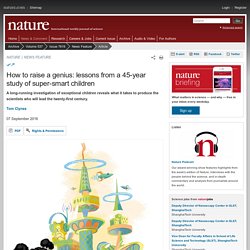
The Baltimore student was so far ahead of his classmates in mathematics that his parents had arranged for him to take a computer-science course at Johns Hopkins University, where Stanley taught. Even that wasn't enough. Having leapfrogged ahead of the adults in the class, the child kept himself busy by teaching the FORTRAN programming language to graduate students. Unsure of what to do with Bates, his computer instructor introduced him to Stanley, a researcher well known for his work in psychometrics — the study of cognitive performance. Bates's score was well above the threshold for admission to Johns Hopkins, and prompted Stanley to search for a local high school that would let the child take advanced mathematics and science classes. Source: K. Start of a study Nurturing a talented child.
The Question That Boosts Motivation And Performance. Self-affirmations are not the best type of self-talk to help motivate you.
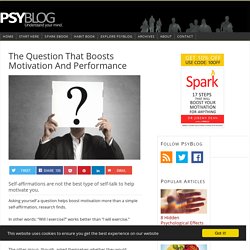
Asking yourself a question helps boost motivation more than a simple self-affirmation, research finds. In other words: “Will I exercise?” Works better than “I will exercise.” In the study one group of people told themselves they would complete an anagram task. The other group, though, asked themselves whether they would complete the task. The results showed that those who asked themselves the question solved more anagrams than those who ordered themselves. Further experiments showed that the questioning approach helped to boost internal or ‘intrinsic’ motivation. Psychologist have found that internal motivation is the strongest type. It is fascinating how a simple change to language like this can help boost motivation. Professor Dolores Albarracin, one of the study’s authors, said: Professor Albarracin continued: